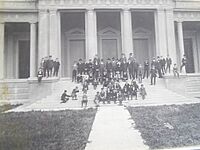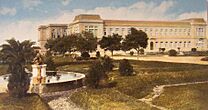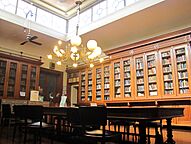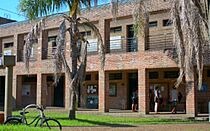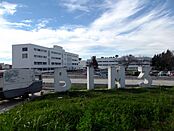National University of La Plata facts for kids
|
Universidad Nacional de La Plata
|
|
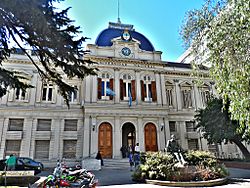
UNLP Rector Office in 2013
|
|
|
Former name
|
Universidad Provincial de La Plata |
|---|---|
| Motto | Pro scientia et patria (Latin) |
|
Motto in English
|
For science and homeland |
| Type | Public non-sectarian higher education institution |
| Established | 1897 |
| President | Martín López Armengol |
|
Academic staff
|
10,400 |
| Students | 91,135 |
| Location | , , |
 |
|
The National University of La Plata (Spanish: Universidad Nacional de La Plata, UNLP) is a big public university in La Plata, Argentina. It's a place where many students learn and teachers do important research. Over 90,000 students attend, and there are 10,000 teachers. The university offers 106 different study programs across 17 departments.
The UNLP is more than just a university. It includes special schools like the Rafael Hernández National College and the Victor Mercante Lyceum. It also has the La Plata University Radio and the La Plata University Press. Plus, it's home to amazing places like the La Plata Museum of Natural Sciences and the Astronomical Observatory. There's even a special retreat for artists and writers called Samay Huasi.
The university first opened on April 18, 1897. Back then, it was called the Universidad Provincial de La Plata. In 1905, a government minister named Joaquín V. González decided to make it a national university. He also added many local science centers to it. Today, the UNLP has one of the most important collections of old animal remains (paleontology) and human history (anthropology) in South America.
Contents
History of the University
How the University Started
In 1880, the city of Buenos Aires became the capital of Argentina. This meant the Province of Buenos Aires needed a new capital city. So, La Plata was founded in 1882. But La Plata didn't have a big university for higher learning.
To fix this, some provincial senators suggested creating a university in La Plata in 1889. People in La Plata were very excited about this idea. Many young people and groups showed their support right away.
The law to create the university was passed on January 2, 1890. It said the new university would have four main study areas: Law, Medicine, Chemistry and Pharmacy, and Math and Physics.
The university was supposed to open that same year. But there were delays. Finally, on February 8, 1897, the rules for the university were approved. The first meeting of the university leaders happened on February 14. They chose Dardo Rocha, who founded La Plata, as the first head of the university. Classes began on April 18, 1897, in the building that is now the Rector's office.
Becoming a National University
In its early years, the university faced challenges. It didn't have many students or a large budget. From 1897 to 1905, only 573 students joined. This was partly because La Plata was still a small city. Also, the degrees from this provincial university weren't recognized nationally. This made the University of Buenos Aires more popular.
At this time, Joaquín V. González, who was the minister of justice and education, had an idea. He wanted to create a big national university using the existing provincial one. In October 1904, he worked with local leaders to make this happen. On January 1, 1905, some parts of the provincial university, like the Veterinary and Agronomy Faculty and the Astronomical Observatory, became national.
On August 12, 1905, the entire university, including the La Plata Museum, the La Plata Observatory, and other schools, was taken over by the national government. The government promised to create a strong university.
The creation of the National University of La Plata was approved by the Argentine government on September 25, 1905. On March 17, 1906, Joaquín V. González was elected as the first president of the new National University of La Plata.
By 1908, the university had many different faculties, or departments. These included:
- Social and Legal Sciences
- Agronomy and Veterinary Medicine
- Physical Science, Mathematics, and Astronomy
- The Museum Faculty (which included Natural Sciences, Chemistry, and Pharmacy)
- A Department for Primary and Secondary Studies
- A Library and University Extension programs
- An Astronomical Observatory
In 1908, the university had 1,845 students. Joaquín V. González led the university for four terms, until 1918.
Changes and Student Movements
A big movement called the University reform in Argentina started in 1918 at the Universidad Nacional de Córdoba. This movement wanted many changes for universities in Argentina. Some of the main ideas were:
- Free university education for everyone.
- Students having a say in how the university was run.
- Universities being independent from the government.
- Flexible study plans.
- Programs that helped the wider community.
These ideas spread to many universities in Argentina and other parts of Latin America.
The National University of La Plata already had some programs to help the public. But in other ways, it was slower to change. Some people felt the university was run by a small, powerful group. They wanted more student involvement and shorter terms for leaders.
In 1919, the university council allowed students to participate in discussions. In October 1919, a student strike happened. In 1920, things became more intense, and a student was sadly killed during a conflict. This led to strong disagreements between different student groups.
The president of the university, Rodolfo Rivarola, resigned in June 1920. Professor Alejandro Korn became a key leader for the reform movement. He helped make some changes, like closing a student boarding school that students felt was unfair.
Student activism continued in the 1920s. Even though big changes didn't happen right away, students kept the reform ideas alive. They formed a group called Renovación (Renewal), which later became known as FULP (Federación Universitaria de La Plata). This group was very active in cultural events on campus. During this time, the university's radio station, LR11 Radio University, was also created.
From 1931 to 1943, a period known as the "infamous decade" in Argentina, student participation in universities was limited. The government took more control over universities. However, students and teachers fought against this. Many students and teachers who had been removed were later allowed to return.
In 1935, a new president, Julio Castiñeiras, took office. During his time, a student aid association was created. This group, supported by the university and students, offered health care, dental services, a community kitchen, and a pharmacy.
In 1938, the number of students reached 9,443. When World War II started, there were tensions because the university's policy of neutrality meant students and staff couldn't make political statements. In 1941, Alfredo Palacios became president. He wanted the university to return to its original idea of different departments working together.
From 1943 to 1955, the government had more control over national universities. In 1943, Alfredo Palacios's leadership was stopped because he disagreed with government rules. From 1952 to 1955, the university was briefly renamed Eva Perón National University, as the city of La Plata was also renamed Eva Perón City.
Artistic Activities
The UNLP is not just about studies; it also has many artistic groups!
The Choirs
The University Choir was the first artistic group at the university, started by students in 1942. It was the first university choir in Argentina. Their first performance was on September 19, 1942.
The choir's motto is "Friendship through Music." They have inspired many other university choirs to start. Since 1959, they have held the La Plata Festival of University Choirs every year.
The choir sings many types of music, from old classical pieces to religious songs, and popular Argentinian and Latin American music. They also sing negro spirituals.
The choir has traveled a lot. In 1965, they performed in the United States, including at the opening of the Lincoln Center in New York. In 1970, they toured Europe, performing in cities like Rome, Paris, and Vienna. They also participated in international music festivals in Spain (1995) and Venezuela (2000).
The Coro Juvenil (Youth Choir) started in 1983 and has won several awards. They sing music from the Renaissance to modern and popular folk songs.
The Chamber Choir was created in 1985. Its goal is to help young singers become professionals and to focus on 20th-century music.
The String Quartet
The University String Quartet (Cuarteto de Cuerdas) was formed in 1953 by teachers from the College of Fine Arts. They gave their first concert on October 5, 1953. The university officially recognized them in 1958. This quartet has performed new music by famous Argentinian composers. Their music ranges from classical to modern pieces.
Its current members are:
- 1st Violin: José Bondar
- 2nd Violin: Fernando Favero
- Viola: Roberto Regio
- Cello: Siro Bellisomi
The Wind Quintet
The Wind Quintet of the UNLP started in 1979. In 1982, the university made it an official group. The Wind Quintet plays classical music for the public.
Their music includes pieces from the Romantic period, classical period, and 20th-century composers. They also play folk and popular songs.
As of 2005, its members are:
- Marcelo Mancuso (flute)
- Cristian Cocchiararo (oboe)
- Roberto Palomo (clarinet)
- Calos Nalli, (horn)
- Eduardo Rodriguez (bassoon)
University Theater
The Theatre Workshop of the National University of La Plata began on May 5, 1986. Its goal is to encourage artistic creativity and research in theater. The group creates experimental plays for the public. It also helps with advice on different artistic skills. This workshop has roots in an older theater group from the 1920s student reform movement.
What You Can Study: Academic Units
The UNLP has many different faculties, which are like schools or departments, where students can learn. Here are some of them:
- Faculty of Architecture and Urbanism (designing buildings and cities)
- Faculty of Arts (music, painting, sculpture)
- Faculty of Agriculture and Forestry (farming and forests)
- Faculty of Astronomic and Geophysic Sciences (stars, planets, Earth's physics)
- Faculty of Economic Sciences (money, business, economy)
- Faculty of Exact Sciences (math, physics, chemistry)
- Faculty of Law and Social Sciences (laws and society)
- Faculty of Medical Sciences (medicine and health)
- Faculty of Natural Sciences and Museum (biology, geology, museum studies)
- Faculty of Veterinary Sciences (animal health)
- Faculty of Humanities and Education Sciences (history, literature, teaching)
- Faculty of Informatics (computer science)
- Faculty of Engineering (building things, technology)
- Faculty of Dentistry (teeth and oral health)
- Faculty of Psychology (how the mind works)
- Faculty of Journalism and Social Communication (news and media)
- Faculty of Social Work (helping communities)
- Fine Arts High School "Professor Francisco Américo de Santo"
- Institute of Physics (started in 1905)
University Locations: Campus Groups
The university buildings are spread out in different areas around La Plata, often grouped together:
- West Forest group: Here you'll find the Faculties of Engineering, Architecture and Urbanism, Exact Sciences, Dentistry, and Computer Science. Also, the Rafael Hernández National College and the Joaquín V. González Graduate School.
- East Forest group: This area has the Faculties of Medical Sciences, Natural Sciences and Museum, Journalism and Social Communication, Veterinary Sciences, and Agriculture and Forestry.
- North Forest group: This group includes the Memory House, Faculty of Humanities and Education, Physical Education Department, and Faculty of Psychology.
- Center Forest group: Here are the Faculty of Astronomic and Geophysical Sciences and the Planetarium.
- Center Urban group: In the city center, you'll find the Faculties of Economic Sciences, Law and Social Sciences, Arts, and the Fine Arts High School.
University Symbols
The university's coat of arms (its official symbol) was chosen on February 14, 1897. It shows the City of La Plata holding up the "Light of Science." You can also see the Southern Cross constellation and the coat of arms of the Province of Buenos Aires. The university's special plant symbol is the oak leaf. Its motto is "Pro Scientia et Patria," which is Latin for For Science and the Motherland.
The university also has its own song, or hymn. It was written by Carlos López Buchardo and Arturo Capdevilla. The hymn was first performed on October 23, 1927, to celebrate 100 years since the death of the famous composer Ludwig van Beethoven.
Famous People from UNLP
Many important people have studied or worked at the National University of La Plata. Here are a few:
- Maria Asensio – A Spanish-Argentinian chemist and researcher.
- Raúl Alfonsín (Law degree in 1950) – He became the President of Argentina from 1983 to 1989.
- Florentino Ameghino (professor of geology) – A famous scientist who studied ancient life.
- Adolfo Pérez Esquivel (Nobel Peace laureate) – Won the Nobel Peace Prize.
- Juan José Arévalo (Philosophy PhD in 1934) – A former president of Guatemala.
- Mario Bunge (Physics-Mathematics PhD in 1952) – A well-known scientist and philosopher.
- Marta Cohen – A pediatric pathologist and researcher.
- Estela Beatriz Cols (1965-2010) – A teacher and researcher.
- Genoveva Dawson (1918–2012) – A botanist and professor.
- René Favaloro (Medicine degree in 1949) – He invented the coronary artery bypass surgery, which saves many lives.
- Beatriz Ghirelli – The first woman to graduate as a Mechanical and Electrical Engineer in Argentina in 1938.
- Evelia Edith Oyhenart (Professor of biological anthropology) – A professor who studies human biology.
- Julio Palmaz (Medicine degree in 1971) – He invented the balloon-expandable stent, a device used in heart surgery.
- Emilio Pettoruti – A famous painter.
- Raúl A. Ringuelet (Professor of Zoology) – A professor who studied animals.
- Carlos Saavedra Lamas (law teacher) – A former rector of the university and Nobel Peace laureate.
- Ernesto Sábato (Physics PhD in 1937) – A famous writer.
- Néstor Kirchner (Law degree in 1976) – He became president of Argentina from 2003 to 2007.
- Cristina Fernández de Kirchner (Law degree in 1979) – She was president of Argentina from 2007 to 2015 and later Vice President.
- Florentina Gómez Miranda (Law degree in 1945) – An important Argentine politician.
- Horacio Pagani (Industrial design) – The CEO of Pagani Automobili, a company that makes very expensive sports cars.
- Maevia Noemí Correa (1953, PhD, Natural Sciences) – A scientist.
- Ricardo Piglia – A well-known author.
- Héctor Magnetto – The CEO of a large media company.
- María Luisa Aguilar – An astronomer.
- Juana Cortelezzi (Professor of Geology) – The first woman to become a full professor at UNLP.
- Carlota Sempé – An archaeologist.
- Martín Almada – A human rights activist from Paraguay.
See also
 In Spanish: Universidad Nacional de La Plata para niños
In Spanish: Universidad Nacional de La Plata para niños
- List of universities in Argentina
- Science and technology in Argentina
- University Revolution


